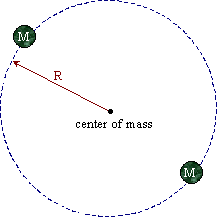Problem 12-59: Binary star - equal masses
Two identical stars, of mass M orbit around their center of mass. Each orbit is circular and has radius R, so that the two stars are always on opposite sides of the circle. a) Find the gravitational force of one star on the other. b) Find the orbital speed of each star and the period of the orbit. c) What minimum energy would be required to separate the two stars to infinity?

> restart;
a) Find the gravitational force of one star on the other.
Just use the known formula for gravitation using values for this situation.
> F:= G*M*M/(2*R)^2;

b) Find the orbital speed of each star and the period of the orbit.
The orbital speed of both stars is the same, because it is a symmetrical situation. To be in equilibrium, the centripetal force has to be equal to the gravitational force.
> v:= solve( F=M*v^2/R ,v)[1];
![]()
Now calculate the period T using the expression for v.
> T:= 2*Pi*R/v;

c) What minimum energy would be required to separate the two stars to infinity?
First calculate the current potential energy. In infinity the energy is zero, so the energy we need is minus the current potential energy.
> U[pot]:= int(G*M^2/r^2,r=2*R..infinity);
![U[pot] := 1/2/R*G*M^2](images/Exercise12-595.gif)
Energy is required for the seperation of the two stars. When the stars are moved away from each other, the rotational speed decreases (this follows directly from the answer to b). This energy has to be distracted from the energy required for seperation of two masses to get the total required energy in this case.
Calculate the kinetic energy for one star
> U[kin]:= M*v^2/2;
![U[kin] := 1/8/R*G*M^2](images/Exercise12-596.gif)
Now substract the kinetic energy two times (for two star)s) from the potential energy needed and the result is the total energy required for seperating the two stars to infinity.
> U:= U[pot]-2*U[kin];
